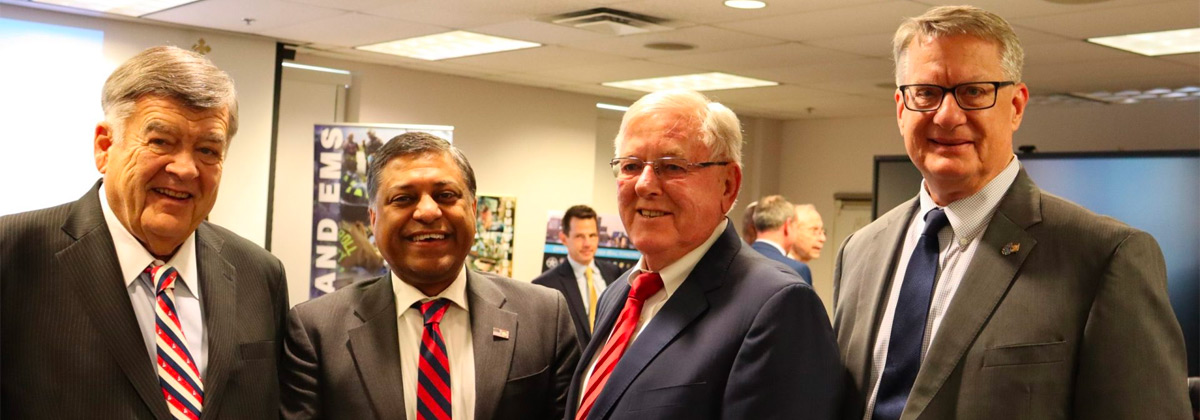
ONDCP Director Dr. Rahul Gupta and U.S. Congressman C.A. “Dutch” Ruppersburger Attend W/B HIDTA Innovations Briefing in Baltimore
Earlier this week, Washington/Baltimore High Intensity Drug Trafficking Area (W/B HIDTA) leadership participated in a briefing for Office of National Drug Control Policy Director Dr. Rahul Gupta, and U.S. Congressman C.A. “Dutch” Ruppersburger at the Maryland Institute for Emergency Medical Systems Services (MIEMSS) in Baltimore. The briefing focused on the innovations in disrupting and dismantling drug trafficking organizations, while offering comprehensive drug treatment and prevention services in the Washington-Baltimore region.
U.S. Attorney for Northern West Virginia and W/B HIDTA Executive Board Vice Chair William Ihlenfeld introduced Director Gupta, and described Director Gupta’s response to West Virginia’s drug problem, his experience as an emergency room doctor, and his voice on the issue on the global level, specifically speaking out about the importance of China becoming more engaged in disrupting the flow of precursor chemicals for drugs
W/B HIDTA Executive Director Tom Carr welcomed both Director Gupta and Congressman Ruppersbuger, and other attendees. He expressed the importance of innovation for addressing the Nation’s drug and drug-related violence problem, and explained how the W/B HIDTA uses its performance management process data to quantify its progress and successes.
Executive Director Carr stated, “The W/B HIDTA has been working hard for many years to develop and implement innovations that enable us to work smarter, and increase our ability to collaborate with many others so that we may work together to prevent and address drug use and drug overdoses across our region. We appreciate Director Gupta’s vision and the support he has provided in the form of discretionary funding for much of what we have discussed today.”
W/B HIDTA Deputy Director for Law Enforcement Gary Hartman highlighted data relating to the number of international, multi-state, and local drug trafficking and money laundering organizations that the W/B HIDTA and National HIDTA Program dismantled and disrupted. He also displayed data on the voluminous amount of fentanyl pills seized in 2021 and 2022 by the National HIDTA Program, and data on the amount of drugs seized, pointing out an increase in the amount of fentanyl seized, and a decrease in the amount of heroin seized in the Washington/Baltimore region between 2021 and 2022. Deputy Director Hartman also delineated a large increase in the amount of fentanyl seized over the past two years in the region.
W/B HIDTA First Deputy Director and Chief of Staff Jeff Beeson described the heroin coordinators project which began in Maryland in 2022, the Overdose Mapping Application Program (ODMAP), Case Explorer, and the Naloxone Saturation Level program. He displayed a map of the top five fentanyl seizures by volume in Maryland, showing fentanyl use is regionally-diverse problem, but with Baltimore City as the major source of supply.
Deputy Director Beeson reviewed the case with the largest fentanyl seizure and how the W/B HIDTA-developed and supported Case Explorer program was used by HIDTA personnel to share information about targets and events across the country. He also highlighted ODMAP, which is used to create a dataset that has reveals how seizures affect overdoses in communities. He connected specific seizures with reductions in drug overdoses as validated by ODMAP data. Deputy Director Beeson gave additional examples of collaboration facilitated by Case Explorer, and the heroin coordinator program in Maryland—which have all resulted in significant seizures of drugs, weapons, U.S. currency, and other assets. Finally, he introduced the new Naloxone Saturation Level program, which will help jurisdictions collaborate and ensure that they will have this potentially life-saving drug where they need it and when they need it, based on overdose occurrence information.
W/B HIDTA Deputy Director for Treatment and Prevention and Director of “A Division for Advancing Prevention and Treatment (ADAPT) Dr. Lora Peppard discussed the development of a fentanyl prevention campaign for middle school-aged children that is designed to lay a strong foundation to prevent any drug use at all for this age group, reduce the escalation of drug use, and reduce overdoses. Additionally, she described ADAPT’s provision of technical assistance to the Maryland Opioid Operational Command Center on best practices for integrating the use of Medications for Opioid Use Disorder (MOUD) in county jails as a treatment intervention for those with opioid use disorders. Dr. Peppard reported that ADAPT personnel conducted a readiness assessment for 19 jails, and created a learning community for supporting cases and reviewing challenges.
State’s Attorney for Baltimore City and W/B HIDTA Executive Board Member Ivan Bates introduced his strategy for change in the Office. He discussed collaborating with the U.S. Attorney’s Office, and focusing on smaller organizations as well as larger organizations to help understand what is happening with drugs and guns in the community. State’s Attorney Bates stressed employing experienced leaders at the top of the Office, as well as using federal resources to obtain younger prosecutors who can be trained by the leadership and others. These prosecutors will learn how to affect individuals from all levels of drug trafficking organizations so that criminals are held accountable in state or federal courts. State’s Attorney Bates also described his intention to address lower-level crime by providing wraparound services, such as drug treatment, to hold individuals accountable and help save people’s lives.
U.S. Marshal for the District of Maryland and W/B HIDTA Executive Board Member Johnny Hughes discussed the community outreach activities U.S. Marshals in Maryland are implementing, including “Operation Bless Baltimore,” in which deputies collect and distribute food, toys, and clothing to communities in Baltimore City. The agency has also been active in supporting Badges for Baseball, which is run by the Cal Ripken, Sr. Foundation. This program uses skill building, recreation, and mentoring to help prevent youth drug use.
Maryland Special Secretary for Opioid Response Emily Keller briefed the group on her newly-created position in the Moore Administration. Secretary Keller stressed the importance of the intersection of public health and public safety to end the preventable overdose deaths in Maryland. She explained that Governor Moore considers expanding access to mental and behavioral health to be one of his Administration’s core priorities; and that the State will address the crisis through innovative and data-driven policy initiatives, including the development of a statewide crisis intervention program, and using front line responders to provide connections to care as opposed to access to local detention centers. She will also use the Data-informed Overdose Risk Mitigation (DORM) initiative to enhance the understanding of the problem and inform policy, and expand the program to include EMS data. Secretary Keller assured the group that the State will use the Opioid Restitution Fund to expand access to care effectively and equitably.
As the briefing concluded, Director Gupta acknowledged, “Talking about HIDTA, it is important to understand that all of this work that happens, it is happening not in a silo but in a system of care that we need to build—and that’s exactly what I hear about from Tom (Carr) and his team about the prevention work, the response, the naloxone work, and (connecting) people to treatment. That’s building an infrastructure.”
For more information on the W/B HIDTA, visit www.hidta.org and sign up for The W/B HIDTA Quarterly Journal e-newsletter on the bottom of the W/B HIDTA’s home page.
